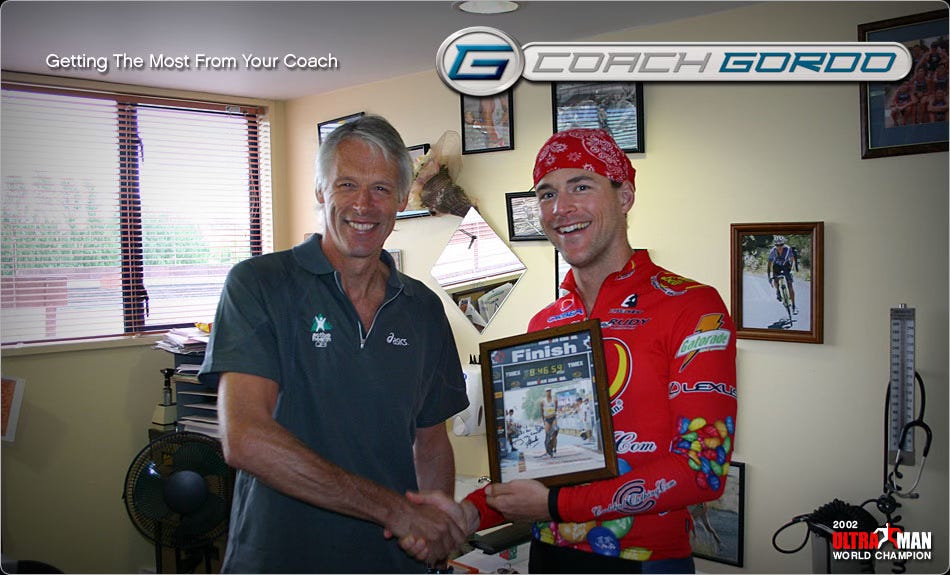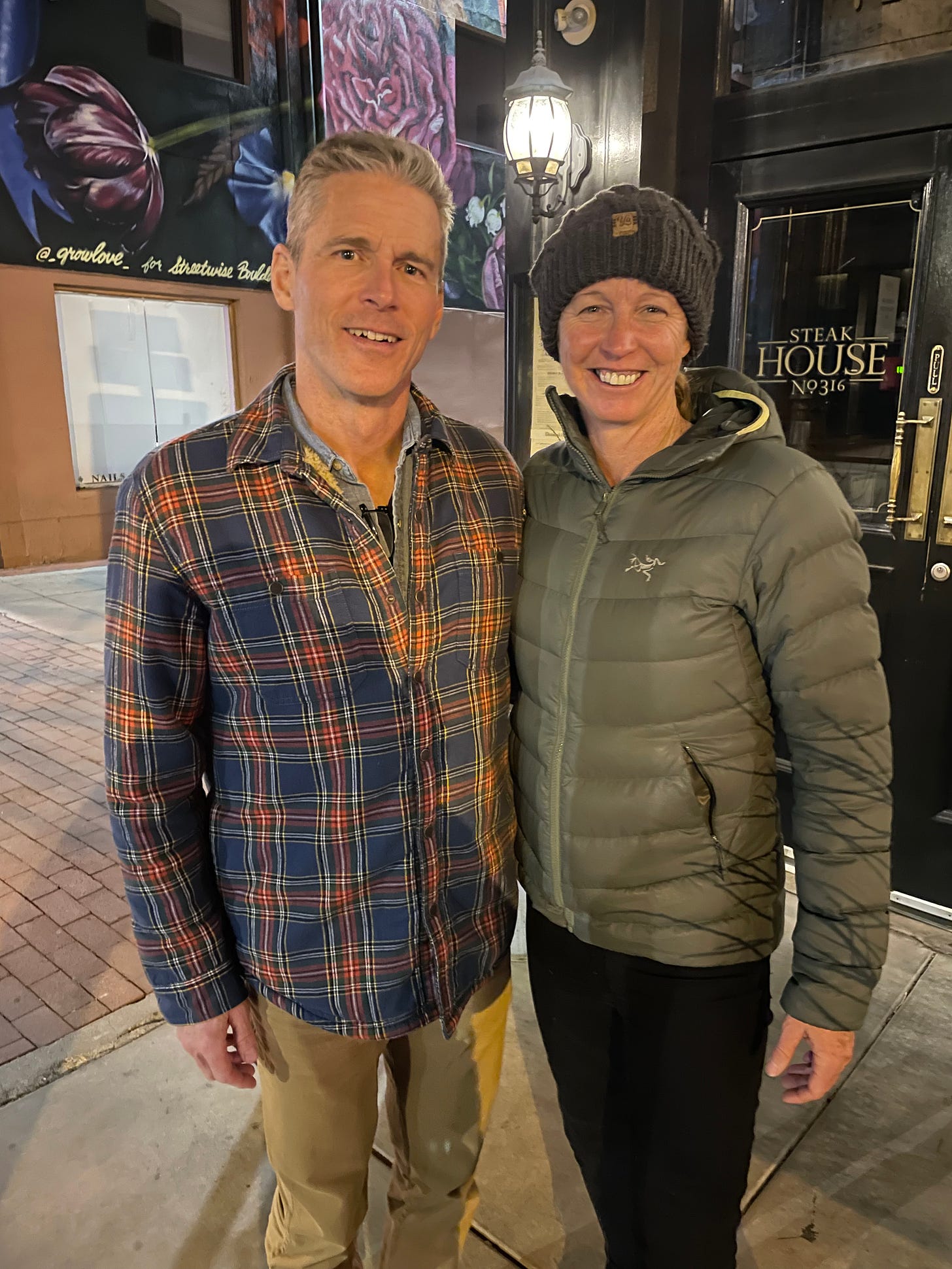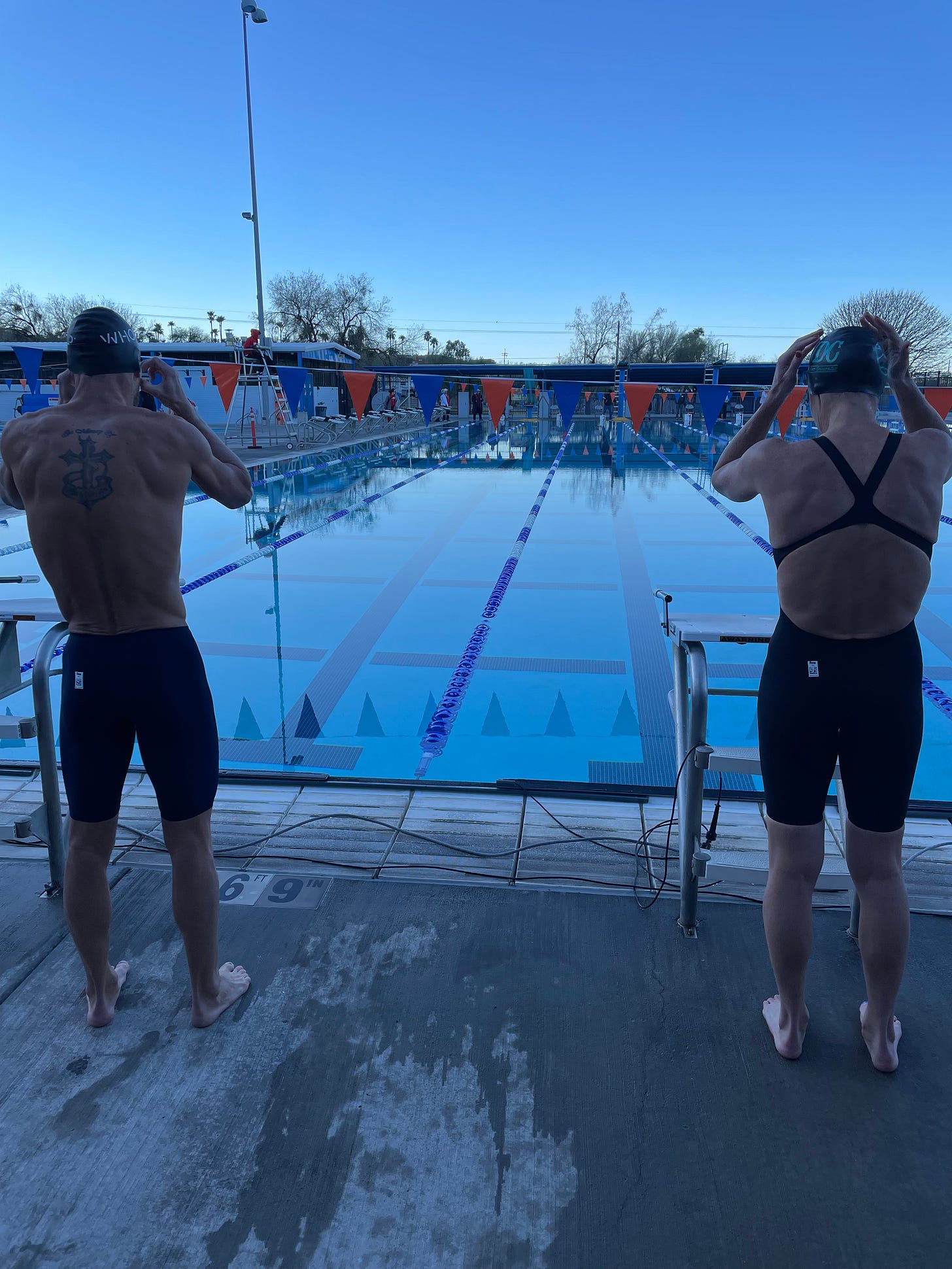I wrote a version of this article 20 years ago. The previous version is aimed at a relatively new athlete. Someone who is seeking a “trainer” to teach them.
The picture below is John and me… back then.

Roll forward 20-ish years and I’ve been thinking about coaching…
For Myself - I joined the JD Crew, overseen by Julie Dibens
For Others1
I started by asking John for ideas.
Find out how the athlete functions, rather than convince him/her to do it your way.
Initially you might just give them workouts
See how they respond
Ask them for feedback
Get to know them
Slowly give them some room to give input, you become a team.
Once they are an established elite, you will act like an advisor.
Be the trainer if they are beginners (give them workouts and tell them why), work with them when they are more experienced (what do they think?), and advise them when they are at the top.
Very few will get to that last step, with most age-groupers you will keep working as the coach-athlete team.
It is so much better to work with athletes than to tell them what to do.
Coach, Team, Teammates
As an athlete, I selected advisors similar to my aspirational self.
I did this because peer group, and environment, greatly influence outcome.
Choose peers & mentors who live in a way you want to emulate.
Being surrounded by excellence works. However, too much similarity creates an environment where everyone shares the same blindspots. I’ve been guilty of this with my coaching and as an athlete.2
How might we gain the benefits while avoiding the pitfalls?
Two years ago, Justin Daerr was talking to me about the benefits of female coaches. Justin noticed certain females in his circle had an approach complementary to highly-motivated males. At the time, I hadn’t returned to training. I filed the conversation away for future reference.
Roll forward and I started swimming with an elite squad, who are mostly female. The elites had a profoundly positive impact on my mood, energy and outlook.
From my True Wealth article:
VIBE - Several times a week, I’m in the same “room” as world-class people working towards difficult goals. I say “room” because it’s actually a swimming pool and the “people” are Olympians. It’s an awesome vibe. Associating with excellence lifts us.
My article from 20 years ago gave you a checklist. I’d like to add the following:
Technical Knowledge
An Environment of Excellence
Being Watched
To Perform Better
To Get A View From Outside (of my obsessions)
Mood, Energy & Outlook
Different Blindspots
Ethics (personal excellence vs win at all costs)
I want to highlight a few things.
Technical Knowledge
There is no special knowledge. I say this having left no stone unturned. You have many options when it comes to learning the craft of your sport.
Don’t focus on Aspirational Similarity.
Do focus on Environment and Ethics.
Environment
Above, I talked about environmental excellence.
Let’s flip that script.
I’ve studied world-class athletes who were driven by never being satisfied with themselves. Their lack of self-satisfaction spilled into their coaching and was a disaster for athletes who lacked confidence.
Notice how the coach, and team, make you feel.3 If you don’t feel right then get out, and stay away. The last thing we need is an environment that works against our mental health.
Ethics
Long before we run into trouble with in-sport ethical lapses, we see unusual things in the coach’s personal life. If it doesn’t feel right then get out. Even if the coach works with people who match your aspirational self... Get Out.
There is constant stream of “the shocking inside story of” for athletes who ignored this advice.
+++
When we get the above correct we will experience:
A Better Allocation of Energy
Improved Willingness To Change
A Positive Sum Group Experience
1-2-3-4 is what you want to see in your program.
The First Year
My buddy, Alan Couzens, has a favorite saying…
Give Your Coach Something To Work With.
When I started back, in the Spring of 2022, I thought the initial step would take 1000 days. Turns out it took two years. I always underestimate the power of small compound gains.
If results matter then, once you have something to work with, consider bringing on a coach.
Why?
John told us at the start:
Find out how the athlete functions, rather than convince him/her to do it your way.
Initially you might just give them workouts
See how they respond
Ask them for feedback
Get to know them
This “get to know you” phase will take at least one year. It’s a big investment for coach & athlete.
John has been through hundreds of “get to know you” situations. He advises:
Getting to know the athlete involves not only wanting to know what they think but also how they think, which has a lot to do with their personality.
If you and your athlete struggle to connect, consider doing some psychometric testing and comparing results. This is best done under the supervision of an expert (often a psychologist). It has helped me and the athletes I coached a few times during my career.
When I was head coach of the Dutch High Performance Triathlon Programme (2010-2013), we did routine psychometric profiling (Action Profiling Questionnaire) with all the athletes. We discussed the results with each other openly. It helped accelerate the process of connecting with the athletes and vice versa (as they also got to see my profile as well).
What I’ve asked Julie:
Learn my physiology.
Make sure I know you’re watching me.
Invite me to everything.
The initial phase can seem counterintuitive, to both the coach and athlete.
Why are you paying the coach?
Access to the environment.
Share of mind, while the coach learns the athlete’s physiology.
Trusting the coach to correct & guide.
We get a better outcome when watched.
My wife, Monica, joined the team before me. Recently, she became the fifth fastest American woman (all-time) in her Masters Agegroup for the 1500 LCM.
Her assessment…
There is no way I could have done the work required without the group.
Coach, Team, Teammates
Back to Table of Contents
As of March 2024, I’m not back coaching 1:1. I am keeping my schedule open until I’ve finished my book with John. If you’re in Boulder then reach out to Julie. You’ll find me at many of the JD Crew group sessions. Training is my best environment - it’s a good place to interact with me.
My Case Study on Overtraining is an example of the dangers of shared blindspots. Clas and I mutually reinforced what made us great… until it made us sick.
My article, An Education in Crazy, discusses the hazards of sketchy male coaches and other people you will encounter in sport.








